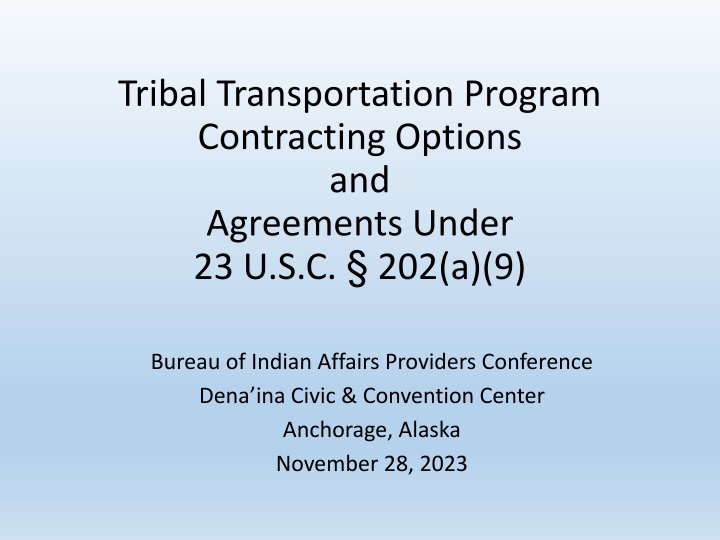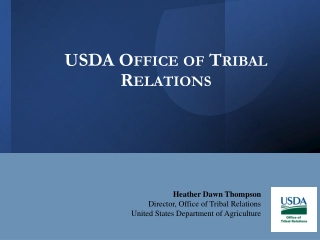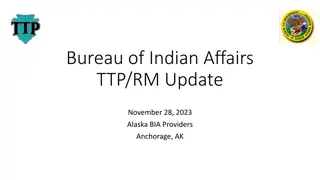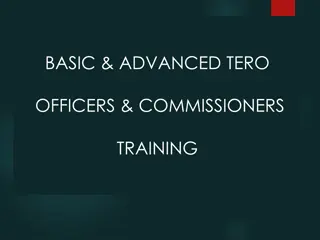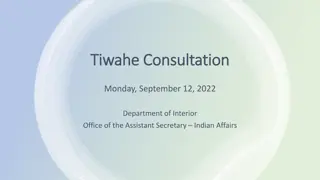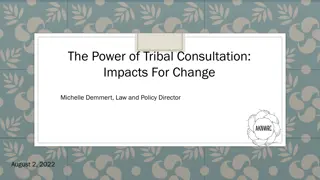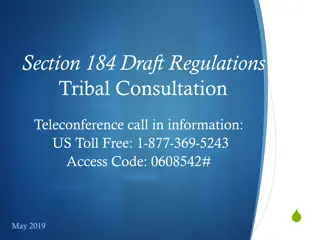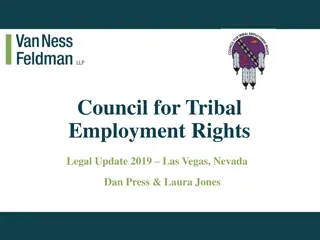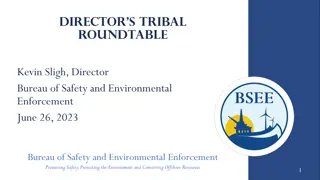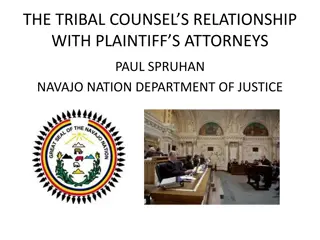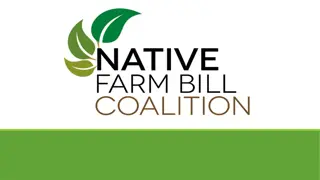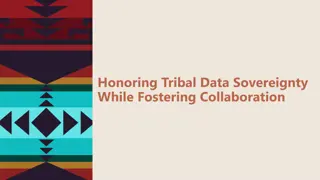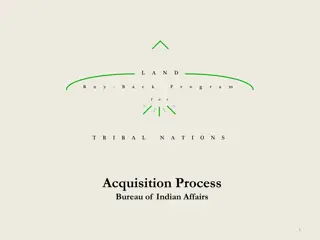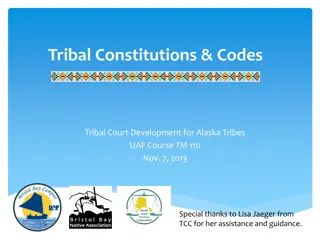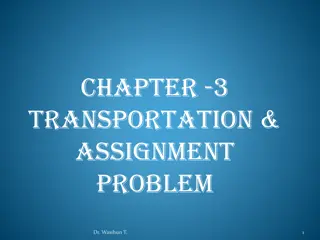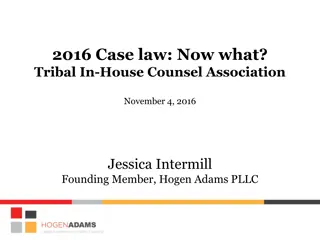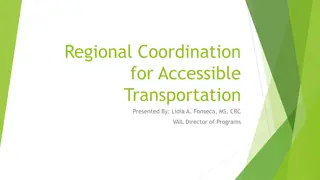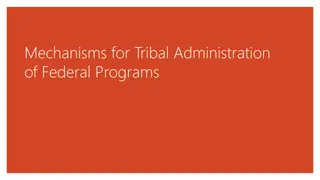History of Tribal Transportation Program Evolution
The evolution of the Tribal Transportation Program, from its origins under the Department of the Interior to the establishment of the Federal Lands Highway Program and its subsequent amendments and expansions through key legislative acts, has shaped the program into what it is today. The shift towards tribal involvement in planning and contracting has been pivotal in empowering tribes to manage their transportation infrastructure.
Download Presentation

Please find below an Image/Link to download the presentation.
The content on the website is provided AS IS for your information and personal use only. It may not be sold, licensed, or shared on other websites without obtaining consent from the author.If you encounter any issues during the download, it is possible that the publisher has removed the file from their server.
You are allowed to download the files provided on this website for personal or commercial use, subject to the condition that they are used lawfully. All files are the property of their respective owners.
The content on the website is provided AS IS for your information and personal use only. It may not be sold, licensed, or shared on other websites without obtaining consent from the author.
E N D
Presentation Transcript
Tribal Transportation Program Contracting Options and Agreements Under 23 U.S.C. 202(a)(9) Bureau of Indian Affairs Providers Conference Dena ina Civic & Convention Center Anchorage, Alaska November 28, 2023
How Did We Get Here? History of the Tribal Transportation Program Under Title 23 Before 1982, authorization and appropriations for roads on tribal lands owned by the United States in trust for the benefit of Indians flowed under the Department of the Interior. 1982 Surface Transportation Assistance Act (STAA) Created the Federal Lands Highway Program (FLHP), bringing together authorization and funding for roads on lands owned by the United States, including tribal lands of over 500 Federally-recognized tribes. Known as the Indian Reservation Roads Program (IRR), projects were selected by Bureau of Indian Affairs (BIA) on a relative need basis, and carried out by BIA through direct service or by tribes under a self-determination contract (also known as a 638 contract ). Authorized Funding - 1983 at $75M; 1984 through 1986 at $100M
History of the TTP 1987 - Surface Transportation Uniform Relocation Assistance Act (STURAA) Amended 23 USC 140 (d) to allow Indian Employment Preference on Federal-aid Projects. Tribal Employment Rights (TERO) as an allowable cost. Authorized Funding - 1987 through 1991 at $80M
History of the TTP 1991 Intermodal Surface Transportation Efficiency Act (ISTEA) Tribes authorized to become involved in transportation planning process. Directed the establishment of an IRR Inventory. Tribal Transportation Assistance Centers (TTACs) established. Authorized Funding 1992 at $159M; 1993 through 1997 at $191M. 1998 Transportation Efficiency Act for the 21st Century (TEA-21). Mandated negotiated rulemaking for new program regulations (25 CFR 170). Authorized Funding: 1998 at $225M; 1999 2004 at $275M. New IRR regulations published in July of 2004 and included: Construction funds allocated based on a relative need distribution formula known as tribal shares. Tribes with few or no roads in the IRR inventory received little funding. Scope of contractible activities expanded; BIA role begins to shift from delivering projects in the field to program management and oversight.
History of the TTP 2005 Safe, Accountable, Flexible and Efficient Transportation Act A Legacy for Users (SAFETEA-LU) Authorized tribes to contract with FHWA in accordance with P.L. 93-638. Authorized tribes to expend up to 25% of their IRR funds on maintenance. Authorized Funding - 2005 at $300M; increased incrementally until 2009 at $450M, where it remained under the SAFETEA-LU extensions through 2012.
History of the TTP 2012 Moving Ahead for Progress in the 21stCentury (MAP-21) Changed name to Tribal Transportation Program. Enacted statutory funding formula to replace negotiated formula in Part 170. New formula looked to historical data and annual population reports to determine tribal shares. 2% set-aside for safety projects. Under 23 U.S.C. 202 (a)(9), authorizes states to transfer any funds to tribes (via FHWA/BIA) for construction and improvement projects with oversight by FHWA or BIA. Authorized Funding 2013 through 2015 at $450M.
The FAST Act 2015 Fixing America s Surface Transportation Act Established an Office of Self-Governance at US DOT, and directed negotiated rulemaking for regulations governing DOT s new self-governance program. Authorized Funding 2016 at $465M, rising incrementally to $505M for FY2020. No other significant changes.
Surface Transportation Surface Transportation Reauthorization Act of 2021 Reauthorization Act of 2021 The Surface Transportation Reauthorization Act of 2021 (STRA-21) was enacted as part of the Infrastructure Investment and Jobs Act (IIJA). Also known as the Bipartisan Infrastructure Law, or BIL, IIJA was signed into law by President Biden on November 15, 2021. Increased Tribal Transportation Program Funding starting at $578.4 million for FY2022 and rising to $602.4 million for FY2024. New set-aside for HPP. 8
STRA STRA- -21 21 cont d cont d Added several note provisions, e.g., not numbered like 202(a), involving: Environmental reviews for safety projects (45- days); Programmatic agreements for making categorical exclusion determinations under the National Environmental Policy Act; Road maintenance study; Tribal Transportation safety study; and Amending and funding the Tribal High Priority Projects Program. 9
TTP Contracting Options TTP Contracting Options TTP authorization mandates that all funds be contracted in accordance with the Indian Self-Determination and Education Assistance Act, Pub. L. 93-638, as amended (ISDEAA). BIA s contracting mandate is found at 23 U.S.C. 202 (b)(6). 10
TTP Contracting Options TTP Contracting Options cont d cont d In practice, these contracting options include: Traditional self-determination contract project by project, aka 638 contract. Tribes are entitled to a 638 contract, provided that the proposed work is contractible and funds are available. Tribal Transportation Program Agreement (PA). TTP Addendum to Annual Funding Agreement under Self-Governance Compact. Direct Service. FHWA s contracting mandate is found at 23 U.S.C. 202 (b)(7). PAs only. DOT Self-Governance Compact 23 U.S.C. 207. 11
TRIBES, LIKE STATES, ARE PUBLIC AUTHORITIES Public authority. The term public authority means a Federal, State, county, town, or township, Indian tribe, municipal or other local government or instrumentality with authority to finance, build, operate, or maintain toll or toll-free facilities. 23 U.S.C. 101 (a)(22)
Like States, Tribes Must Have a FHWA-Approved Transportation Improvement Program Before Expending Funds on a Project Use of funds. Notwithstanding any other provision of this section, funds made available to Indian tribes for tribal transportation facilities shall be expended on projects identified in a transportation improvement program approved by the Secretary. 23 U.S.C. 202 (b)(4)
The Facility Must Also Be On The National Tribal Transportation Facility Inventory In general. The Secretary of the Interior, in cooperation with the Secretary [of Transportation], shall maintain a comprehensive national inventory of tribal transportation facilities that are eligible for assistance under the tribal transportation program. 23 U.S.C. 202 (b)(1)(A)
Cooperation of States and Local Governments The cooperation of States, counties, or other local subdivisions may be accepted in construction and improvement. 23 U.S.C. 202 (a)(9)(A)
BIA and FHWA May Administer and Oversee Funds Received From States or Their Political Subdivisions any funds received from a State, county, or other local subdivisions shall be credited to appropriations available for the tribal transportation program. 23 U.S.C. 202 (a)(9)(B)
Challenges For Tribes, States & Local Governments States & local governments are usually not familiar with Chapter 2 of Title 23 and the TTP. Yet Tribes are increasingly seeking a place at the table for state or other non-tribal projects on their lands, partly as a result of taking on all but the inherently Federal functions of the TTP under Program Agreements and other TTP contracting options. Politics of tribal-state relationships sometimes interfere with finding effective solutions benefitting tribes, states, counties, other governments and the traveling public.
Funding Sources That May Be Eligible for a 202 (a)(9) Agreement Overall - Federal-aid and other funds Transportation Enhancement Surface Transportation Program Strategic Highway Research Program Other discretionary funds from programs authorized under Title 23, or any other funds from a state, county, or other local subdivisions. Otherwise consistent with the mission of BIA-DOT and FHWA.
Potential Projects Using Federal Potential Projects Using Federal- -Aid Funds Aid Funds Consistent with Chapter 1 of Title 23: Access roads. Highway Safety Improvement Program. State, county, town and other local roads. Interstates or interchanges. Transportation Enhancement.
BIA & FHWA BIA & FHWA Coordination Coordination Educating states and FHWA Division offices about the new law. Finding opportunities. 25 CFR 170.627 requires an agreement among Tribe, State and BIA/FHWA describing source and use of funds. BIA or FHWA becomes responsible for oversight of the funds and project. Negotiable if the project is on a state-owned facility.
Model Agreements Model Agreements What s Old is New? What s Old is New? The Old FAST Act model agreement Comprehensive and flexible. Originated from pre-202(a)(9) deals between several Tribes in Minnesota, the State of Minnesota and the BIA. First FAST Act 202(a)(9) agreement entered into among LaJolla, the State of California, and the BIA. Grew to include multiple states, as noted below. FAST Act Multi-project agreement based off model was entered into among Salt River, State of Arizona and the BIA. 21
Model Agreements Model Agreements What s Old is New? What s Old is New? Using the FAST Act multi-project agreement as a base, the BIA and Tribes in Arizona and Minnesota, and their states respective DOTs, have entered into an Intergovernmental Fund Transfer Agreement (IFTA) that runs for the term of STRA- 21, including any extensions. The STRA-21 IFTAs act as a master document, thereby requiring only an addendum for each project, not an entirely new agreement as in the past. 22
QUESTIONS? 23
Contact Information Andrew S. Caulum Senior Attorney Office of the Solicitor Division of Indian Affairs United States Department of the Interior Direct Line (202) 208-7024 E-mail Andrew.Caulum@sol.doi.gov
